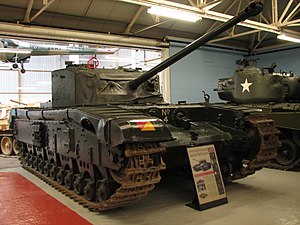Black Prince (tank)
| Tank, Infantry, Black Prince (A43) | |
|---|---|
 Tank, Infantry, Black Prince (A43) | |
| Type | Infantry tank |
| Place of origin | |
| Production history | |
| Designer | Vauxhall Motors |
| Designed | 1943 |
| Produced | 1945 |
| No. built | 6 prototypes |
| Specifications | |
| Mass | 49 t |
| Length | 7.7 m (25 ft 3 in) |
| Width | 3.4 m (11 ft 2 in) |
| Height | 2.7 m (8 ft 10 in) |
| Crew | 5 (Commander, gunner, loader, driver, co-driver/hull gunner) |
| Armour | 152 mm (6.0 in) |
Main armament | QF 17 pdr |
Secondary armament | 2 x 7.92 mm Besa MG |
| Engine | 2 x Bedford Flat 12 350 horsepower (260 kW) |
| Suspension | sprung bogie |
Operational range | ~ 100 miles (160 km) |
| Maximum speed | road: 11 mph (18 km/h) off-road: 7 mph (11 km/h) |
The Tank, Infantry, Black Prince (A43) was the name assigned to an experimental development of the Churchill tank with a larger, wider hull and a QF 17-pounder (76 mm) gun. It was named after a 14th century figure, Edward, Prince of Wales, who fought at Crécy.
As a development from the Churchill, the Black Prince was a continuation of the line of Infantry tanks, that is tanks intended to operate in close support of British infantry. The parallel development in British tank design were the Cruiser tanks which were intended for more mobile operations.
The cruiser line of tanks led to the Cromwell tank (and the 17 pounder armed Challenger variant) and then the Comet tank, (which had a variant of the 17 pounder gun) entering service during the war. While not as heavily protected as the Churchill the Comet showed the way tank development was going and the last of the cruiser line and the first of the "Universal tanks", the Centurion tank was approaching completion.
In the light of the slow speed of the Black Prince and the 17 pounder armament of the Centurion, the Black Prince project would be limited. Only six prototypes were completed while the first Centurions were rushed to Germany to try to beat the wars end.
The only surviving Black Prince tank is held by the Bovington Tank Museum.

